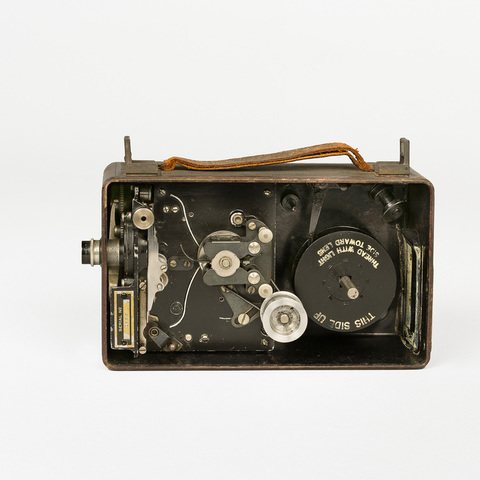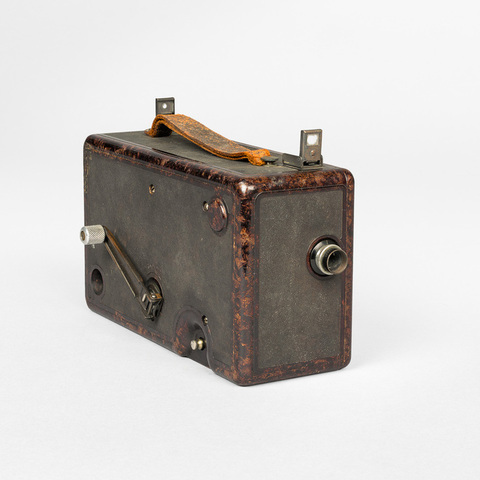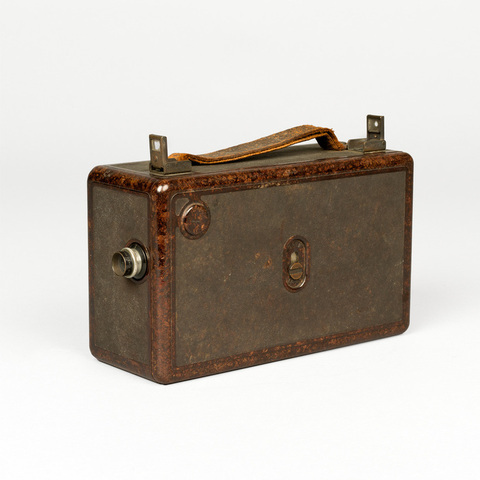Caméra film 16 mm
Fiche détaillée
Type de l'appareil
entraînement du film 16 mm par deux griffes ; un débiteur denté ; moteur à ressort ; emplacement intérieur pour deux bobines 16 mm co-axiales pour 30 m ; manivelle ; viseur pointeur ; compteur de pieds ; poignée cuir
Auteurs
Informations non disponibles
Fabricants
Kodel Electric Manufacturing Company
Cincinnati, Ohio, 507 East Pearl Street
Utilisateurs
Informations non disponibles
Distributeurs
Kodel Electric Manufacturing Company
Cincinnati, Ohio, 507 East Pearl Street
Sujet du modèle
Informations non disponibles
Objectif
Wollensak Cine Velostigmat F. 3,5
Taille de l'objet
Ouvert :
Informations non disponibles
Fermé :
Longueur : 23.5 cm
Largeur : 9.5 cm
Hauteur : 16 cm
Diamètre :
Informations non disponibles
Taille de la boîte de transport
Informations non disponibles
Remarques
Marque : "Manufactured by The Kodel Electric & Mfg. Co. Cincinnati, Ohio".
Inscrit au dos : "Kemco HoMovie camera exposure guide. Caution hold camera steady. Dark days, 3,5. Close-ups in cloudy or shady, 4. Close-ups in direct sunlight, 5,6. Average scenes in direct sunlight, 8. Distant subjects in direct sunlight, 11. Distant snow scenes / Distant water scenes, in bright light, 16. For other light conditions, see manual. Manufactured by The Kodel Electric & Mfg. Co. Cincinnati, Ohio. Patents pending".
Caméra conçue par H. B. Ridge et Clarence Ogden, pionniers de la radio et propriétaires de la firme Kodek Electric and Manufacturing Company. La particularité de cette caméra, c'est qu'elle impressionne quatre images au lieu d'une sur la pellicule 16 mm, ce qui permet d'obtenir des séquences plus longues (mais avec des images plus petites et un mécanisme spécial). Un projecteur adéquat a été commercialisé.
"The principal object of the present invention is to provide apparatus wherein marked economy of operation and maintenance over similar equipment heretofore in use is attained. In accomplishing this result, the present invention utilizes standard motion picture film now on the market, either 16 mm or 35 mm, but uses such film in such manner that for any given footage, four times the duration of exposure or projection is attained, as, compared with the apparatus presently in use ; that is, the duration of the scene, or scenes, photographed or projected by our apparatus is to the duration of scene or scenes, photographed or projected by the apparatus heretofore in use, as four is to one. [...] It has previously been proposed in cinematographic cameras in which the film received a step by step transverse movement and also had imparted to it a longitudinal movement either after every second transverse step or after a number of these steps are known. According to the present invention we provide a cinematographic camera of that type in which the film of standard width for motion picture cameras is shifted alternately one-half width and then one-half height of an image section, and in which the portion of the film receiving the image is carried by a movable film plate, characterised by a transverse bar to which said film plate is secured and an uninterrupted cam disc acting on said bar for imparting thereby to the film plate and portion of the film carried thereon a reciprocating movement transversely of the lenght of the film. The present invention also includes on the film supporting plate a longitudinal slot and claws alternately entering said slot, said claws being actuated by the film drive mechanism and being adapted to advance the film longitudinally subsequent to the lateral displacement and exposure of the film" (The Kodel Electric & Mfg. Co., British patent n° 356 768, convention date (USA) July 16, 1929, application date in UK June 5, 1930, complete accepted, Sept. 7, 1931, "Improvements in Cinematographic Apparatus").
Bibliographie
Filmtechnik, 23 novembre 1929.


